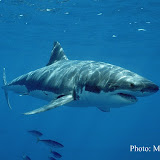Guadalupe Island is fast becoming a 'buzz' location for divers, thrill-seekers and shark enthusiasts around the world. Once an obscure rock far off the beaten path, Isla Guadalupe now attracts visitors from around the globe including noted scientists and professional film crews. While the local Great White Shark population is definitely the star attraction, the island's lesser mentioned attributes make this destination truly unique.
 |
| The South End of Isla Guadalupe |
Located 150 miles off the coast of Baja California, Mexico, Guadalupe Island can truly be considered remote. While the island hosts a small airport nearly all visitors make the open ocean crossing by boat. The island's remote location makes access challenging to say the least, but it also helps the island maintain its pristine environment.
A 2008 census recorded a population of 15 persons on the island but that number is subject to constant change as the local Naval presence swells or the amount of seasonal fishermen grows. Ten months out of the year 30 families of the Abuloneros and Langosteros of Guadalupe Island are present. The inhabitants fish for both Lobster and Abalone during their respective seasons and the product is taken to the mainland for sale. Housing on the island is primitive and in many respects so is day to day life.
 |
| Campo Norte at the North End |
Isla Guadalupe is best known for its marine environment - most notably the population of
Great White Sharks - but the island itself is home to varied plant and animal life as well as breathtaking geography. Guadalupe Island's terrain is best described as rugged, consisting of two overlapping shield volcanoes, of which the northern and higher volcano is the younger. The island is roughly 22 miles long and six miles wide. The northern end is home to the highest elevation with Mount Augusta reaching 4,257 feet at its peak. While the southern part of the island remains barren, the northern end is host to several fertile valleys and numerous tree stands.
 |
| The Infamous Goat |
A look at Guadalupe Island isn't complete without a reference to what was once its most reviled inhabitant - the goat. Russion whalers and sealers brought the goats to the island in the 19th century for provisions when stopping over but in a short amount of time the goats went feral and took control of the island. At one time the island was nearly void of plants taller than a few centimeters. It didn't take long for the available food source to diminish and the once strong population of 100,000 dwindled to a few thousand. Unfortuantely the damge was done - numerous plant species endemic to the island were gone forever, and with them several bird species as well. In 1928 the island became a nature conservancy (making it one of the oldest in Mexico) and an effort to eradicate the goats was launched. This task was challenging to say the least but as of 2005, when the island became a Biosphere Reserve the task was completed.
 |
| Researchers Preparing a White Shark Biopsy |
Perhaps the greatest travesty of the goats insatiable hunger was the decimation of the local tree poulation. Guadalupe Island was home to several large species (Guadalupe Palm, Guadalupe Cypress, Island Oak and the Guadalupe Pine)but as the goats devoured the seedlings only old trees were left. With time, as large trees fell and new ones failed to take their place, the forests dwindled. This created an immediate effect on the island's ability to retain water as the once populous forests collected water from the plentiful fog at the northern end of the island. To restore this lost balance, fences were installed to protect seedlings from the goats allowing many tree species to grow to size for the first time in 150 years.
As part of Guadalupe Island's main user group, Islander Charters fully promotes and supports the ongoing efforts to protect the island and its surrounding waters. As
research continues and solutions are devised the strength of this island and others like it increases. Part of our commitment includes an ongoing effort to educate the public by bringing them face to face with nature. Whether it's staring into the eyes of a 3,000 pound Great White Shark or watching the sun set over this majestic rock we recognize that nothing beats a hands-on approach when it comes to truly recognizing the complexities of nature.












